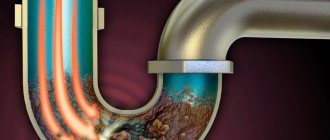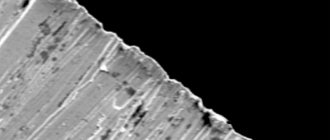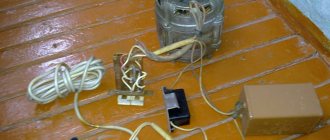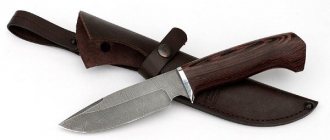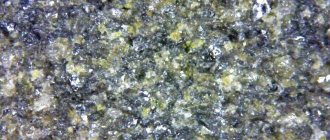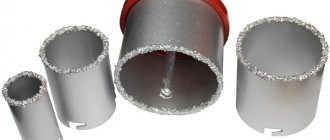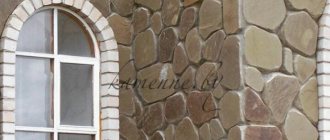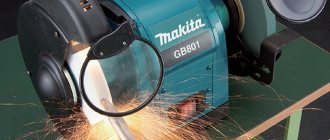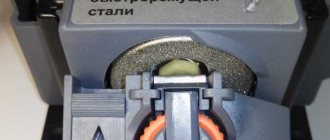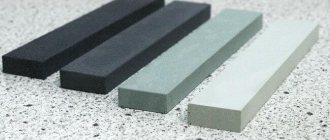We all constantly use a tool such as a knife, at least for cooking. In many occupations and professions, the knife is also used for other operations. And, of course, for normal operation it must be sharp.
But not everyone knows how to give the cutting edge that same razor sharpness or, at worst, the ability to cleanly cut the required material. After all, in order to sharpen a blade, you must first decide on a sharpening tool.
Why a whetstone?
In order to restore lost sharpness to knives (or give it to them for the first time), there are many devices. There are hand-held sharpeners made up of several abrasive discs, and electric devices, even large sharpening machines that are used in enterprises.
For obvious reasons, you won’t keep bulky equipment at home. As for manual sharpeners, their big disadvantage is the inability to set the sharpening angle, as well as the fact that the blade runs along the working part, which leads to accelerated wear of the knife. In addition, such sharpening does not last long.
Unlike previous options, a sharpening stone (or whetstone) gives the owner of the knife a certain freedom of action, for example, choosing the angle at which the cutting edge will be processed.
If you reach a certain level of skill, then with the help of a set of sharpening stones you can bring the knife to the state that craftsmen demonstrate in the video: shaving, cutting hair on the fly, or cutting off the transparent layers from a tomato without holding it with your hands.
How to make a whetstone with your own hands
You can make your own whetstone from ceramic tiles or silicon carbide and epoxy glue, but first you need to prepare a template and then follow the instructions.
From ceramic tiles
You need to take a fragment of ceramic tile measuring 30x8 cm; if there are mortar residues on the back side, then they must be removed. The relief side of the ceramic tile is ground down on a grinding wheel or sand-lime brick by active friction. During this process, fine abrasive dust will be formed - it must be removed periodically. You can bring the surface completely smooth with regular sandpaper.
As soon as the back side of the ceramic tile becomes smooth, the remaining abrasive particles are removed/washed off and completely dried. The whetstone is ready, you can use it to sharpen your kitchen knives, but you will definitely have to sharpen them until they are impeccably sharp and smooth.
Watch the video on how to make a whetstone for finishing a knife from ceramic tiles:
Made of silicon carbide powder and epoxy glue
You need to purchase 100 g of silicon carbide powder, prepare a wooden board with cuts on one side to fix the abrasive bar, and epoxy glue. For ease of work, you should wear medical gloves and use syringes.
Execution order:
- Mix 6 cubes of resin and 1.2 ml of glue (epoxy glue preparation kit) in a bowl.
- Mix thoroughly and add a little abrasive powder.
- Stir again and add silicon carbide powder again - this must be done until the dry material runs out.
Next, you need to prepare a cardboard box of the desired shape (a rectangular or square block is needed) and pour the prepared adhesive mixture into it. Cover the top with a board, sawn side down, and press down with a weight.
After 3-4 days, the glue will completely harden - and the block is ready for use. You will need to clean its edges and trim it with a file. To make the surface abrasive, you need to drop water on it and rub the frozen surface with a piece of glass with a small amount of sand.
Homemade sharpening stone for knives is ready
Such homemade sharpening stones do not have a long service life, but can be useful in force majeure circumstances.
Types and selection criteria
Sharpening bars vary greatly in properties and price. What suits the housewife in the home kitchen may not suit the knife collector who wants to achieve excellent results with outstanding examples. But that’s the beauty of sharpening stones: everyone can choose a product to suit their needs and wallet.
Natural sharpening stones
People had to sharpen knives, weapons and agricultural implements long before industry began producing sharpening stones. Initially, the tools were stones of suitable shape and structure, with a smooth and slightly rough surface. Even today, after half an hour of searching, an experienced tourist will find a cobblestone in the scattering, which will significantly improve the cutting characteristics of a dull blade.
Natural sharpening stones produced by various companies have the same origin. Since the end of the 18th century, they have been mined in special deposits. Large blanks cut and carved into rocks are cut to the required sizes, after which they are given a perfect geometric shape already in production conditions.
The main characteristic of a natural sharpening stone that makes it valuable is its chemical composition and physical characteristics. For proper operation, it is necessary that the source material contains the necessary inclusion of solid particles of a certain size.
In the modern market, well-known brands of such stones are quite expensive - primarily as a result of the marketing policies of companies. Searching for new deposits of raw materials for natural sharpening stones and their subsequent processing is a very expensive process; it is much cheaper to produce artificial materials with the desired characteristics. Those companies that have a history and production experience present their products as a brand, making a good profit.
However, the sharpening and cutting properties of natural stones are really good. By selecting products of different grain sizes, you can achieve impressive results. In addition, good natural material is quite resistant, wears out and wears out slowly. With careful use it will serve the owner for many years.
Known variants
There are several deposits from which the company receives raw materials for the production of finished sharpening stones of natural origin.
"Arkansas". Received its name from the location of the mine workings in the USA. Arkansas stone is the mineral novaculite. It is rarely found in nature, which led to its high price. It consists of no less than 97% silicon oxide, while the crystals are very small in size, which allows the use of Arkansas stones for finishing and grinding. Arkansas stone bars are produced by different manufacturers. Users can also find the name "Washita".
An entire culture has developed around Arkansas whetstones. On the Internet there is a trade in samples that were made back in the 19th century. Accordingly, their price is very high. You can also find information that at the moment all the quarries in which raw materials were extracted are already closed, hence the high cost. It is quite difficult to verify this, but novaculite stones continue to be produced to this day.
Arkansas stone varies in grain size and degree of abrasive effect. Sometimes manufacturers designate this by color (gray, black), in other cases - by a general verbal marking (“Hard”, “Truehard”). The instructions for Arkansas blades recommend using oil when sharpening, which, however, does not prevent users from using water.
Artificial
Industrial production has made it possible to obtain abrasive bars with the required parameters of hardness, grain size and abrasion resistance. They come in different brands, are made from specific raw materials, and vary greatly in cost. For example, in a hardware store you can easily find a product for 100 rubles, which sometimes may not even have packaging. Such a block, even after careful culling, can only be used to set the angle of the cutting edge.
Famous manufacturers produce high-quality synthetic bars that are no cheaper than natural Arkansas bars. The reason is the homogeneity of the structure, strictly observed hardness parameters, uniform wear, the absence of burrs and chips when processing the knife.
Expert opinion
Levin Dmitry Konstantinovich
Synthetic sharpening stones are produced using similar technology. The basis is an abrasive powder with a certain particle size (it determines the future grain size). Microgranules are held together using a binder (for example, Bakelite or other plastics). The resulting viscous mixture is pressed into molds, when not only the pressure but also the temperature increases. As a result, the composition seems to sinter and has good hardness indicators, although in terms of fragility it is significantly inferior to natural stones.
Emery (abrasive)
The most famous and frequently used. They can be produced as single products with a specified grain size, or in the form of sets, usually including two or three stones - for coarser and finer sharpening, as well as for finishing. Another way to increase the versatility of the stone is a double-sided design: during the manufacturing process, two portions of a mass of abrasives with different characteristics are sintered longitudinally.
Various high-hardness substances are used as the main composition: electrocorundum, artificial diamonds, CBN, chromium oxide, various silicates. The price and quality range of such stones is very wide. Japanese water stones, made under the careful supervision of experienced craftsmen, can cost several thousand rubles.
Most emery stones require the use of water during the sharpening process. The bar is either completely immersed in water to soak for 5 - 10 minutes, or periodically sprayed as it dries. Wetting promotes the formation of an emulsion of particles of the bar, water and removed metal at the point of contact between the blade and the abrasive layer. This makes the processing more subtle and prevents the formation of creases and chips.
Diamond
It is often a metal base, on which a thin coating of a mixture of synthetic diamond chips or powder with the addition of other abrasives is applied on one or both sides. Such stones are quite expensive, but they provide consistent results even with knives made of high-hardness carbon steel.
True, no less often you can find sharpening stones in which the place of diamond is, at best, taken by borazon. This makes them significantly cheaper, but offers almost no advantages over sanding blocks.
Ceramic
Ceramics are clay and its derivatives that have undergone heat treatment. Technologies make it possible to produce ceramic sharpening stones with minimal grain size. It is notable for its low cost, but at the same time it regularly aligns the cutting edge of knives made of different steels.
A significant part of ceramic bars, due to their relative softness and smooth surface texture, are used not so much for sharpening as for straightening knives. The most suitable area of application is working with stainless steel kitchen knives.
Unlike other materials, ceramics are often shaped not like a bar, but into another shape: a tube, a thin cylinder. Such sharpeners are used both independently and as part of sharpening kits.
Stones for sharpening knives: the best by manufacturer
The best manufacturers of stones for sharpening knives are considered to be Russia, Japan, China and the USA; Soviet-made tools can still be found on sale, and many professionals prefer them.
Russian made: Petrograd, Grinderman, Gritalon
Sharpening stones, which are produced in Russia, are distinguished by the correct price-quality ratio.
Of the most popular, it is worth highlighting:
Title Description Photo “Petrograd”
This brand produces silicon carbide stones that are distinguished by a variety of surface hardness. It is important that the degree of graining exactly corresponds to Japanese standards - they are recognized throughout the world as the best.
“Grinderman” Production is located in St. Petersburg, the company not only produces various sharpening tools, but also provides full service.
“Gritalon” produces synthetic abrasive tools that can be used both for sharpening machines and for manual work. The material used in production is silicon carbide.
Japanese: Suehiro, YOSHIKIN, Yaxell, Samura
Sharpening stones made in Japan are usually used for manual work and with water; the most famous brands of such tools are:
- Suehiro;
- Yoshikin;
- Yaxell;
- Samura
The difference between such stones is that when sharpening cutting surfaces, new layers of abrasive are constantly “opened”, and particles of the previous ones are mixed with water and have the best possible effect on the blade.
The Japanese produce sharpening stones with different degrees of grain, so when using a tool with fine grains at the last stage, it makes it possible to bring the cutting surface to perfect condition without the additional use of pastes, felt and dressing slings.
Japanese water stones are distinguished by the highest productivity, which can only be compared with diamond tools. But the latter increases the risk of excessive thinning of the blade at the final stage of finishing the cutting surface.
Japanese whetstone grit standards are recognized by international organizations and are used for designation by most manufacturers.
Soviet
Soviet sharpening stones are bars of absolutely regular shape, onto which a coating of abrasive material (base – silicon) was applied. You can still find Soviet sharpening stones and whetstones on sale at flea markets - they are considered high quality and “eternal.”
On the territory of the USSR, they used their own, individual markings, which are radically different from modern ones.
What was indicated on each product:
- dimensions;
- accuracy class;
- manufacturer (each had its own mark);
- dimensions;
- hardness level;
- structure characteristics;
- product type;
- material used in manufacturing;
- grain level.
Microcorundum block for straightening USSR razors, 1970
Chinese: Ganzo
Chinese sharpening tools include silicon carbide and aluminum oxide stones, which are characterized by fairly high quality, long service life and low cost. The most famous manufacturer is Ganzo. Such tools are especially good for sharpening ordinary kitchen knives - their grit level does not exceed 1000 grit, which allows you to bring the blade to the desired sharpness with one whetstone.
Recently, sharpening stones from China made of vacuum ceramics and boron carbide have appeared on the market. They have an almost eternal service life; even with prolonged sharpening of the tool, they do not wear out.
Chinese sharpening tool Ganzo
Arkansas: Dan's, Smith's, Lansky
Three companies stand out from the manufacturers:
- Dan's;
- Smith's;
- Lansky
Arkansas is a state in America where abrasive material is mined and grindstones are produced. Mineral reserves in this part of the country are already greatly depleted, so the cost of the tool is very high even by the standards of the Americans themselves. However, Arkansas stones have always been popular and are now considered the best quality on the market.
Grain
The most important parameter that determines the nature of work with a sharpening stone. The larger the granules included in the bar, the more metal it will remove in one pass of the blade across the surface. Accordingly, finishing stones are almost smooth to the touch - tactile sensations simply do not provide information about the size of the grains.
What type of sharpening stone do you have at home?
NaturalArtificial
The grit measurement scale differs in countries that produce knife sharpening materials. Thus, in the USSR the size in microns was adopted, which, however, is still used today as an equivalent. But Western manufacturers use a system of conventional units called grit, that is, the degree of roughness. This quantity is dimensionless.
The general rule is this: the lower the grit value, the larger the particles and rougher processing await the owner of the knife. Large values of several thousand grit indicate finishing, grinding and even polishing stones.
Today there are several standards in force:
- FEPA (for European manufacturers of sharpening stones);
- JIS (Japanese products are labeled according to it);
- ANSI (adopted in the USA and applies to American products).
Expert opinion
Levin Dmitry Konstantinovich
Grit roughness values are not exact values and values may vary among different standards. Therefore, you need to purchase a stone for a knife based on your experience and needs, trying different options.
Grit of sharpening stones
Even amateur sharpening on stones is not something simple, always successful the first time. Those who have never used such abrasives are faced with the first problem of “what stone to buy.” And the grain ratio is also important in this choice. Grit is grit (sometimes written “gridness”), this term from experts can often be heard regarding this characteristic of stones. The value of this parameter determines how aggressively the stone will act on the metal.
Description of the effect of grain size.
- Large grains inevitably leave deep gouges and chips on the metal surface, and no one wants that. Because ideally, after sharpening, a sharp and even edge should form, preferably a mirror edge, without any visible defects. Therefore, large grains can be used exclusively when working with blanks, for example, for a newly forged blade.
- Fine grains are used for metal grinding and finishing polishing. You will have to tinker with such a stone longer, but all for the sake of optimal results.
- Knives are sharpened with medium grain if the blade is slightly dull.
It turns out that ideally the set should contain 3 double-sided stones: with the finest grain, medium and coarse. A guide to your choice can also be a grain size table with classes from 1 to 14.
Question answer
How to clean the bar when it gets dirty?
Under running water using a not very hard brush. Many people wipe off traces of the suspension after drying with a regular eraser.
What else can you sharpen and trim stones besides knives?
Relatively speaking, everything that is less hard and preferably plastic (metal): scissors, chisels, manicure tools, axes, scythes and sickles (if you are making a film about the harvest in pre-revolutionary Russia).
What oil should I use when sharpening with Arkansas?
In general, this is not important, since any oil will give the desired effect. Considering that knives can be used for cooking, you can take edible vegetable oil - olive, linseed. For tourist and technical knives, a spindle or ballistol is better suited.
Using a stone to sharpen knives indicates that a person loves knives and does not mind spending a few minutes (or tens of minutes) on sharpening and finishing. Well, a good sharpening stone pays its owner with good results.
Main criteria when choosing a stone
- small;
- average;
- large.
Coarse grain is used primarily to eliminate chips on the cutting surface due to the intensive removal of the damaged metal layer.
Then you should decide on the origin of the material. In terms of their technical characteristics, synthetic instruments are superior to natural ones. This statement is true for the average price category
To purchase a high-quality sharpening device, it is better to pay attention to Japanese-made products
Select your area of use. For sharpening home knives, dimensions do not matter, but on a long hike, the extra weight will definitely be of no use.
Shaped whetstones and whetstones for wood carvers
Water-wet stones, which vary in shape according to the type of carver's tool, are available in three grades: coarse, medium and fine.
To straighten semicircular chisels and chisels or woodcarver's tools, small stones of various shapes are required. For this purpose, natural and artificial stones of various grain sizes, moistened or oiled, are used. Drop-shaped and conical whetstones are the most common, but special rectangular and knife-shaped versions also exist, plus a large selection of whetstone “files” in square, round and triangular cross-sections. Wet combination whetstones are used for sharpening staples, axes and garden tools.
Grit selection
The grit of sharpening stones (abrasiveness) is the number and size of the particles that make up a particular type of sharpening stone. With a large grain size, sharpening stones will erase the metal layer from the blade faster and more roughly; it can easily leave scratches and burrs. Such bars are used to change the shape of the blade or to quickly process it initially, which makes it possible to remove large chips and scratches from the damaged surface. In the future, it will be possible to use a more abrasive, soft whetstone for sharpening. Soft sharpening stones are used to finalize the blade to remove scratches and abrasions and polish it to a mirror shine.
It is best to have a large selection of stones of different grain sizes. This will allow you to choose the best option in each specific case. To sharpen knives, it is recommended to use several types of abrasive, starting with harder ones and gradually moving to soft ones. Since an ordinary kitchen knife interacts with ceramic plates and other hard materials every day, there is no point in using soft stones right away. Hard Arkansas-type whetstones or hard synthetic whetstones are best, as they give the knife a distinctive shine when sharpened. For scissors, slightly stiffer types are used, as this avoids too many particles from soft stones getting into the metal.
How can you more accurately determine the grain size of a sharpening stone? For this purpose, there are special tables of grain size, which indicate its coefficients depending on the materials. A table for sharpening stones allows you to determine what grit is needed for each type of knife.
| Material | Density, kg/m3 | Mooca Hardness | Relative abrasiveness | Temperature resistance, °C |
| Natural diamond | 3520 | 10 | 1,0 | 700-800 |
| Artificial diamond | 3500 | 10 | 0,8 | 700-800 |
| Corundum | 4020 | 9 | 0,10-0,14 | 1700-1800 |
| Electrocorundum | 3900 | 9 | 0,14-0,16 | 1250-1300 |
| Silicon carbide | 3200 | 9 | 0,25-0,45 | 1300-1400 |
| Quartz | 2700 | 7 | 0,05-0,07 | 1500-1800 |
| Boron carbide | 2500 | 9 | 0,40-0,50 | 700-800 |
